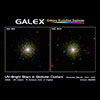Feature Story
Galaxy Evolution Explorer Hunts for Stellar Misfits
Scientists are hoping the powerful ultraviolet eyes of NASA's Galaxy Evolution Explorer (GALEX) will help shed some light on a species of stellar misfits called "blue stragglers," which are old, hot objects that have puzzled astronomers since their discovery 50 years ago.
Blue stragglers are found in "globular clusters," densely packed "forests" of old stars scattered in galaxies across the universe.
A team of GALEX guest investigators led by, Dr. Ricardo Schiavon of the University of Virginia, Charlottesville, Va., are attempting to capture these stragglers and other ultraviolet bright sources in several Milky Way globular clusters for further study.
Many scientists suspect that blue stragglers are formed from collisions or intimate encounters between two old stars in a densely packed cluster. If this theory is correct, Schiavon says astronomers should be finding more stragglers in the cluster's crowded core. However, various observations in the last 10 years have spotted blue stragglers far away from the core, near more dispersed cluster edges, leading many scientists to re-evaluate their theories.
"The blue straggler is an object that has haunted me for decades. The more I study them the more confused I get," says co-investigator Dr. Robert Rood, also of the University of Virginia.
According to team members, blue stragglers have been difficult to detect in the ultraviolet for many reasons. First, they shine at ultraviolet wavelengths bordering blue visible light. This means that, while some visible light telescopes have serendipitously captured them in the past, GALEX, with its near ultraviolet detector, is much better equipped for identifying and studying stragglers. Second, the telescope's wide area imaging capability allows scientists to capture blue stragglers at the center and edge of the cluster all at once. With these new maps, astronomers can pinpoint areas of interest to study in detail with other types of ground- and space- based telescopes.
"GALEX is a perfect surveying tool because its wide field view allows us to capture an entire cluster of millions of stars in one shot," said co-investigator Dr. Robert O'Connell, also of the University of Virginia.
Team members hope their research will eventually enable them to use ultraviolet telescopes to determine the star formation rate of faraway galaxies.
"Using ultraviolet telescopes to accurately measure the star formation rate of a galaxy is very difficult because young stars are also hot and shine brightly in the ultraviolet. Thus when you are looking at the ultraviolet emissions of an unresolved, or fuzzy, galaxy, hot young stars can be confused with old hot stars like blue stragglers," said Schiavon.
"If we want to use ultraviolet telescopes to accurately measure the amount of young stars in a galaxy, we need to understand the ultraviolet properties of old stellar populations."
Like stumbling upon "fools gold" and mistaking it for real gold, the team also admits that identifying blue stragglers can be very tricky. Two stars that are orbiting closely, but not interacting, can emit the same ultraviolet wavelengths as a blue straggler and fool astronomers into believing that they are looking at a straggler, when they are not. Thus, after discovering a potential straggler with GALEX, the team may propose to zoom in on the object with another observatory, like NASA's Hubble Space Telescope.
"Globular clusters contain some of a galaxy's oldest stars, if you want to understand how galaxies evolve or develop, you have to understand globular clusters," said Schiavon.
Another family of stellar oddballs in globular clusters is the Hot Horizontal Branch Stars. In the later stages of their lives, these stars shed approximately 85 percent of their atmosphere and leave behind a very hot ultraviolet bright core detectable by GALEX. These stars are actually easier to detect than blue stragglers because they are hotter and shine brighter in ultraviolet. By being able to put Hot Horizontal Branch Stars in context with stragglers and other ultraviolet sources in a globular cluster, the team can gain a better understanding of how many old ultraviolet sources exist in a distant galaxy.
"We already have enough information about these clusters from Hubble and other telescopes, so that when we combine the GALEX data with observations at other wavelengths, we will have a better understanding of these stellar populations," said Rood.




